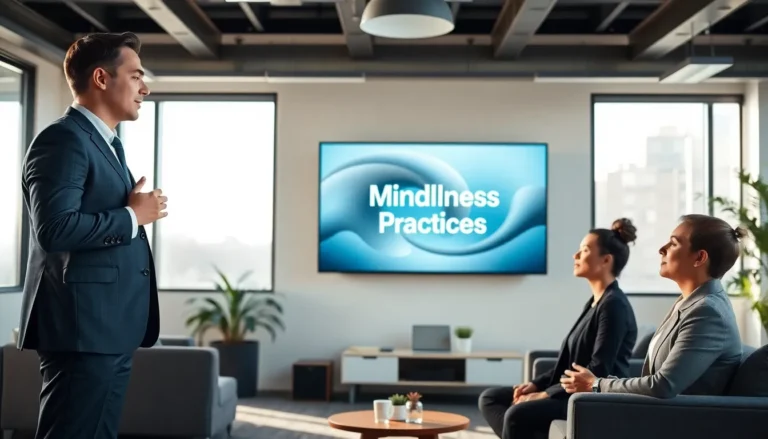Table of Contents
ToggleEver feel like your brain is a tightly locked treasure chest? Well, guess what? The key to that chest lies in creative thinking exercises. Not only can they offer a delightful escape from the mundane, but they also harness the power of your imagination. Imagine turning a boring meeting into a brainstorming bonanza or transforming a simple idea into a groundbreaking innovation. In this text, we’ll pull back the curtain on the magic of creative thinking exercises. Are you ready to unleash your inner genius? Let’s dive right in.
Understanding Creative Thinking

Creative thinking isn’t just about generating wild ideas: it’s about seeing connections where others don’t. This type of thinking allows individuals to break free from conventional boundaries and explore uncharted territories of the mind. In essence, it combines logical reasoning with imaginative perspectives.
Creative thinking can manifest in various forms, whether through art, problem-solving, or innovation. It’s like a gym for the brain, strengthening its ability to adapt and evolve. Those who actively engage in creative thinking often find that their thought processes expand exponentially, leading to more effective solutions and enhanced collaboration. Whether it’s in a workplace setting or an educational environment, understanding its core principles sets a solid foundation for implementation.
The Benefits of Creative Thinking Exercises
Engaging in creative thinking exercises offers a buffet of benefits. For starters, it cultivates greater adaptability in facing challenges. When ideas flow freely, individuals learn to pivot in responses, an invaluable skill in today’s fast-paced world.
Creativity also stirs motivation. Ever come up with a brilliant idea? That feeling of excitement is like rocket fuel for productivity. Also, it enhances collaboration by encouraging diverse perspectives, making team activities more enjoyable and fruitful.
Another compelling advantage is improved problem-solving abilities. Creative thinkers are masters at approaching issues from unexpected angles, often leading to innovative solutions that standard methods might miss. The best part? Regularly practicing these exercises strengthens neural pathways, making creativity a more natural response to challenges as time goes on.
Types of Creative Thinking Exercises
Exploring creative thinking requires a treasure trove of exercises. Here’s a compelling lineup:
1. Brainstorming Techniques
This classic method promotes group participation and uninhibited idea generation. Participants are encouraged to share freely without judgment, leading to a carousel of concepts. The goal is quantity over quality, let the ideas flow.
2. Mind Mapping
Mind mapping is a visual explosion of thoughts, allowing individuals to connect ideas organically. By jotting down a central concept and branching out, one can visualize relationships between thoughts, paving the way for deeper understanding and innovation.
3. Role-Playing Scenarios
Stepping into someone else’s shoes can spark fresh insights. Role-playing exercises simulate real-world challenges, enabling participants to explore different viewpoints and solutions in a safe environment.
4. Random Word Association
Taking a random word and associating it with a project or problem can ignite unexpected connections. This playful exercise nudges the brain towards lateral thinking and unique solutions.
5. The Six Thinking Hats Method
Developed by Edward de Bono, this approach encourages looking at a situation from six distinct perspectives. Each ‘hat’ represents a different angle, rational, emotional, optimistic, etc. This structured method drives comprehensive analysis and encourages collaboration.
How to Implement Creative Thinking Exercises
Implementing creative thinking exercises can be straightforward and enjoyable. Start by identifying the right exercise for your group or individual needs. Create a relaxed and open environment, think of it as setting the stage for creativity.
Begin with a warm-up activity to get everyone comfortable. This could be as simple as a quick icebreaker that sparks laughter. Make sure to establish ground rules: no idea is too outlandish, and all suggestions deserve respect.
After the initial setup, jump into your chosen exercise. Whether it’s brainstorming or mind mapping, emphasize the importance of collaboration and respect. Document all ideas generated, as this can serve as a springboard for future projects.
Finally, follow up on the outcomes. Review the ideas and discuss potential implementations. This reassures participants that their creative contributions matter and encourages ongoing participation.
Tips for Enhancing Creativity
To truly unlock creativity, follow these handy tips:
- Change Your Environment: A fresh perspective can dramatically impact creativity. Try working in a new location or modifying your workspace.
- Embrace Constraints: Sometimes, limitations can spark innovation. Set specific parameters for exercises to challenge thinking.
- Incorporate Play: Integrating playful elements into exercises can lift morale and promote creative thinking. Remember, humor can be a powerful tool.
- Set Aside Time for Reflection: Give your mind space to breathe. Breaks often lead to unexpected insights.
- Seek Diverse Perspectives: Collaborate with people from different backgrounds to enhance creativity. Varied viewpoints stimulate innovative thoughts.




